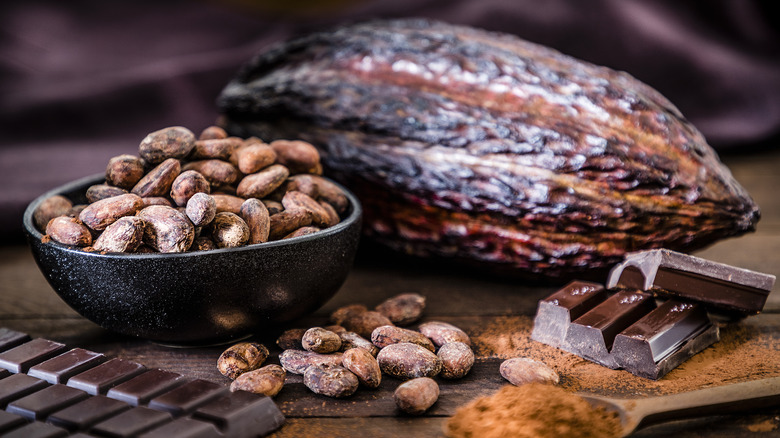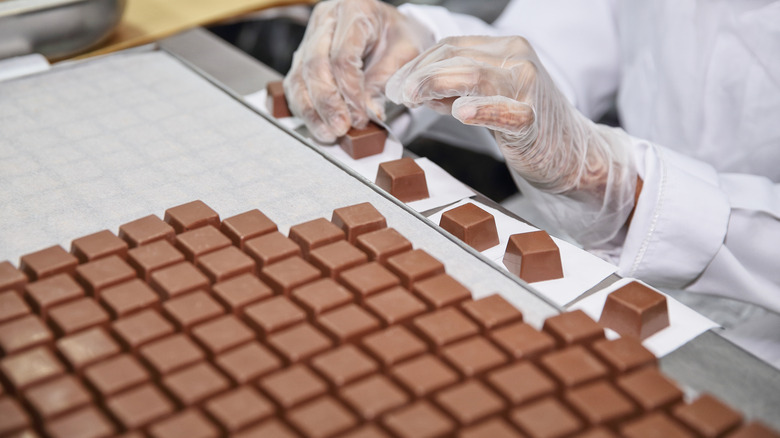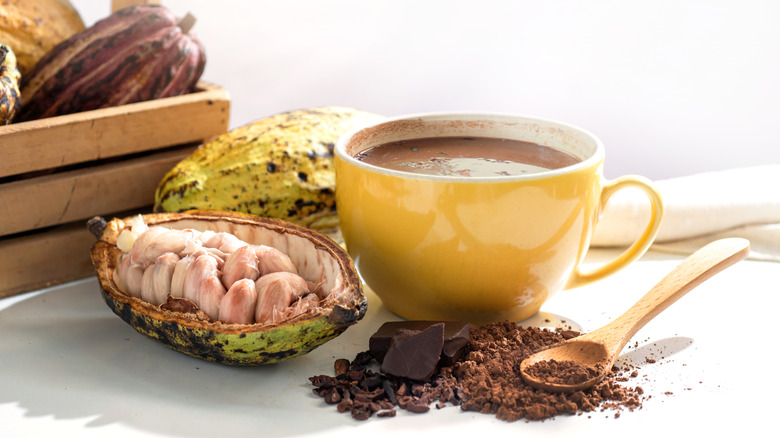Does Cacao Fruit Actually Taste Like Chocolate?
Thanks to goodies like classic chocolate cake and chocolate chip cookies, people in the U.S. eat around 3 billion kilograms of chocolate in one year, per Statista. But, what exactly is chocolate made of and where does it come from? You might be surprised to hear that the rich, sweet stuff is made from a fruit — cacao fruit, to be exact, which houses cacao beans. Once processed and sweetened, it's what makes up those candy bars and baked goods.
Even though they're referred to as beans, however, they're not actually part of the legume family — cacao is the seed of a fruit that grows on the Theobroma cacao tree, a plant native to the rainforests of South America. Cacao fruit has an elongated pod shape, and comes in almost all the colors of the rainbow, from red and green to orange and purple. Raw cacao fruit contains two different elements: the sweet pulp and the seeds known as cacao beans.
The sweet white pulp inside cacao fruit is the mucilage that surrounds the beans, but it doesn't taste anything like chocolate. It has a fruity, tangy taste that's described as a mix of many tropical fruits like lychee, mango, and pineapple. The seeds, on the other hand, have a very different flavor profile. They're bitter and earthy — similar to actual chocolate, but unsweetened and very, very rich.
How does cacao fruit become chocolate?
To turn the fruity pulp and bitter seeds of cacao fruit into the chocolate we know and love, a few steps must take place. First, the pods are chopped from the trees, cut open, and the beans and pulp are removed. This is typically done on a cacao farm. Then, for two to nine days, the beans and pulp undergo a fermentation process when microorganisms like yeast begin to grow, causing the chemical activity that gives chocolate its signature flavor and color. After drying for about seven days, the beans are then sent to a buyer like Hershey's or Mars Wrigley and brought into a factory to be used in a variety of products.
From there, the beans are roasted and cacao nibs are separated; the nibs are what's needed to make the actual chocolate — think of them as the "meat" of the bean. After the nibs are finely ground, they're turned into cocoa liquor (which doesn't contain any actual alcohol). The liquor is mixed with ingredients like sugar and milk powder to achieve that sweet, creamy taste. The chocolate also needs to be tempered, meaning it must be brought to a temperature where the cocoa butter hits peak stability.
Then, at long last, the chocolate is poured into molds to take its final shape. It's then packaged and sent out by truck, sea freight, or air freight to restaurants, candy shops, and grocery stores worldwide.
Cacao is used in a lot more than just chocolate
Cacao fruit is essential to making chocolate, but it's also an important ingredient in plenty of other products, too. The fat from cacao seeds is used in makeup, hair conditioners, and skincare products. Cacao seed butter is ideal because it forms a barrier on the surface of skin and hair, which slows the loss of water and keeps everything moisturized. Cacao is also used to make dyes, which, unsurprisingly, are a rich chocolate brown in color.
The white pulp inside cacao fruit makes a great mixer for a fruity, tangy cocktail. With notes of pineapple and mango, cacao fruit pulp can be added to any drink, bringing a tropical note to each sip. Speaking of drinks, cacao tea is also a thing, and it might just be the best hot beverage you're not drinking. It's made with roasted cacao bean husks, and brings a subtle chocolatey taste to your cup, along with heart-healthy flavonoids and essential nutrients like protein and iron.
Some people even eat cacao beans as-is rather than waiting for them to be turned into chocolate. Since they are pure and not processed, cacao nibs are rich in antioxidants and minerals like magnesium, and there's a plethora of ways to use cacao nibs in the kitchen. They can be used in trail mix, as a topping for oatmeal or smoothies, or added to baked goods for a bitter, subtly chocolatey kick.



